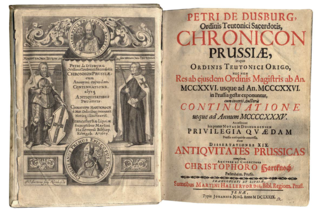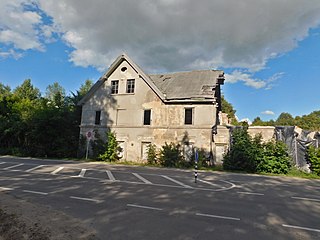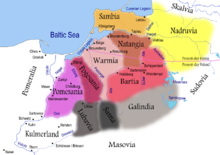The Northern Crusades or Baltic Crusades were Christian colonization and Christianization campaigns undertaken by Catholic Christian military orders and kingdoms, primarily against the pagan Baltic, Finnic and West Slavic peoples around the southern and eastern shores of the Baltic Sea, and to a lesser extent also against Orthodox Christian Slavs.

Sambia or Samland or Kaliningrad Peninsula is a peninsula in the Kaliningrad Oblast of Russia, on the southeastern shore of the Baltic Sea. The peninsula is bounded by the Curonian Lagoon to the north-east, the Vistula Lagoon in the southwest, the Pregolya River in the south, and the Deyma River in the east. As Sambia is surrounded on all sides by water, it is technically an island. Historically it formed an important part of the historic region of Prussia.

Prussia is a historical region in Europe on the south-eastern coast of the Baltic Sea, that ranges from the Vistula delta in the west to the end of the Curonian Spit in the east and extends inland as far as Masuria. This region is often also referred to as Old Prussia. Tacitus's Germania is the oldest known record of an eyewitness account on the territory and its inhabitants. Pliny the Elder had already confirmed that the Romans had navigated into the waters beyond the Cimbric peninsula (Jutland). Suiones, Sitones, Goths and other Germanic people had temporarily settled to the east and west of the Vistula River during the Migration Period, adjacent to the Aesti, who lived further to the east.

The Sambians were a Prussian tribe. They inhabited the Sambia Peninsula north of the city of Königsberg. Sambians were located in a coastal territory rich in amber and engaged in trade early on. Therefore, they established contacts with foreign nations before any other Prussians. However, as all other Prussians, they were conquered by the Teutonic Knights, and, exposed to assimilation and Germanization, became extinct sometime in the 17th century.

Old Prussians, Baltic Prussians or simply Prussians were an indigenous tribe among the Baltic peoples that inhabited the region of Prussia, at the south-eastern shore of the Baltic Sea between the Vistula Lagoon to the west and the Curonian Lagoon to the east. The Old Prussians, who spoke an Indo-European language now known as Old Prussian and worshipped pre-Christian deities, lent their name, despite very few commonalities, to the later, predominantly Low German-speaking inhabitants of the region.

Yotvingians were a Western Baltic people who were closely tied to the Old Prussians. The linguist Petras Būtėnas asserts that they were closest to the Lithuanians. The Yotvingians contributed to the formation of the Lithuanian state.

Lithuania Minor, or Prussian Lithuania, is a historical ethnographic region of Prussia, where Prussian Lithuanians lived, now located in Lithuania and the Kaliningrad Oblast of Russia. Lithuania Minor encompassed the northeastern part of the region and got its name from the territory's substantial Lithuanian-speaking population. Prior to the invasion of the Teutonic Knights in the 13th century, the main part of the territory later known as Lithuania Minor was inhabited by the tribes of Skalvians and Nadruvians. The land depopulated during the incessant war between Lithuania and the Teutonic Order. The war ended with the Treaty of Melno and the land was repopulated by Lithuanian newcomers, returning refugees, and the remaining indigenous Baltic peoples; the term Lithuania Minor appeared for the first time between 1517 and 1526.

Warmians were a Prussian tribe that lived in Warmia, a territory which now mostly forms part of the Warmian-Masurian Voivodeship in Poland, with a small northern portion located in neighbouring Russia. It was situated between the Vistula Lagoon, Łyna and Pasłęka Rivers.

The Bartians were an Old Prussian tribe who were among the last natives following a pre-Christian religion before the Northern Crusades forced their conversion to Christianity at the cost of a high percentage of the native population. They lived in Bartia, a territory that stretched from the middle and lower flow of Łyna river, by the Liwna river, and Lake Mamry, up to the Galindian woods. The territory is quite precisely known from description in Chronicon terrae Prussiae, dated 1326.

Chronicon terræ Prussiæ is a chronicle of the Teutonic Knights, by Peter of Dusburg, finished in 1326. The manuscript is the first major chronicle of the Teutonic Order in Prussia and the Grand Duchy of Lithuania, completed some 100 years after the conquest of the crusaders into the Baltic region. It is a major source for information on the Order's battles with Old Prussians and Lithuanians.

Pogesanians were a Prussian tribe, which lived in the region of Pogesania, a small territory stretched between the Elbląg and Pasłęka rivers, now located in the Warmian-Masurian Voivodeship, northern Poland. Pogesanians, as the rest of the Prussians, were conquered by the Teutonic Knights and became Germanized or Polonized. The old Prussian language became extinct sometime in the 17th century.

Romuva or Romowe was an alleged pagan worship place in the western part of Sambia, one of the regions of pagan Prussia. In contemporary sources the temple is mentioned only once, by Peter von Dusburg in 1326. According to his account, Kriwe-Kriwajto, the chief priest or "pagan pope", lived at Romuva and ruled over the religion of all the Balts. According to Simon Grunau, the temple was central to Prussian mythology. Even though there are considerable doubts whether such a place actually existed, the Lithuanian neo-pagan movement Romuva borrowed its name from the temple.

Herkus Monte was the most famous leader of the Great Prussian Uprising against the Teutonic Knights and Northern Crusaders. The uprising began in September 1260, following the Knights' defeat at the Battle of Durbe, and lasted for the next fourteen years.

The Prussian uprisings were two major and three smaller uprisings by the Old Prussians, one of the Baltic tribes, against the Teutonic Knights that took place in the 13th century during the Prussian Crusade. The crusading military order, supported by the Popes and Christian Europe, sought to conquer and convert the pagan Prussians. In the first ten years of the crusade, five of the seven major Prussian clans fell under the control of the less numerous Teutonic Knights. However, the Prussians rose against their conquerors on five occasions.
Komantas or Skomantas was a powerful duke and pagan priest of the Yotvingians, one of the early Baltic tribes. He was at the height of his power during the 1260s and 1270s.

The Prussian Crusade was a series of 13th-century campaigns of Roman Catholic crusaders, primarily led by the Teutonic Knights, to Christianize under duress the pagan Old Prussians. Invited after earlier unsuccessful expeditions against the Prussians by Christian Polish kings, the Teutonic Knights began campaigning against the Prussians, Lithuanians and Samogitians in 1230. By the end of the century, having quelled several Prussian uprisings, the Knights had established control over Prussia and administered the conquered Prussians through their monastic state, eventually erasing the Prussian language, culture and pre-Christian religion by a combination of physical and ideological force. Some Prussians took refuge in neighboring Lithuania.

Nemirseta is a district of the Lithuanian seaside resort Palanga, located on the Baltic coast north of Klaipėda. The place, which consists mainly of two deserted buildings which were formerly an inn and customs house, is notable for having marked for about five centuries the northernmost point of Prussia and the northeastern tip of the German Empire from 1871 to 1920.

The Prussian mythology was a polytheistic religion of the Old Prussians, indigenous peoples of Prussia before the Prussian Crusade waged by the Teutonic Knights. It was closely related to other Baltic faiths, the Lithuanian and Latvian mythologies. Its myths and legends did not survive as Prussians became Germanized and their culture extinct in the early 18th century. Fragmentary information on gods and rituals can be found in various medieval chronicles, but most of them are unreliable. No sources document pagan religion before the forced Christianization in the 13th century. Most of what is known about Prussian religion is obtained from dubious 16th-century sources.

Pomesanians were a Prussian clan. They lived in Pomesania, a historical region in modern northern Poland, located between the Nogat and Vistula Rivers to the west and the Elbląg River to the east. It is located around the modern towns of Elbląg and Malbork. As the westernmost clan, the Pomesanians were the first of the Prussians to be conquered by the Teutonic Knights, a German military crusading order brought to the Chełmno Land to convert the pagans to Christianity. Due to Germanization and assimilation, Pomesanians became extinct some time in the 17th century.

The Lithuanian Crusade was a series of economic Christian colonization campaigns by the Teutonic Order and the Livonian Order under the pretext of forcibly Christianizing the pagan Grand Duchy of Lithuania. The Livonian Order occupied Riga in 1202 and the Teutonic Order conquered Culmerland in the 1230s. They first conquered other neighboring Baltic tribes—Curonians, Semigallians, Latgalians, Selonians, and Old Prussians—in the Livonian Crusade and Prussian Crusade.










